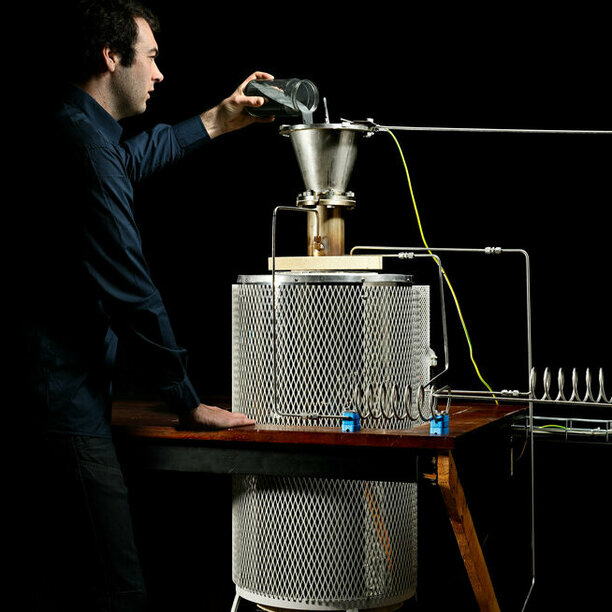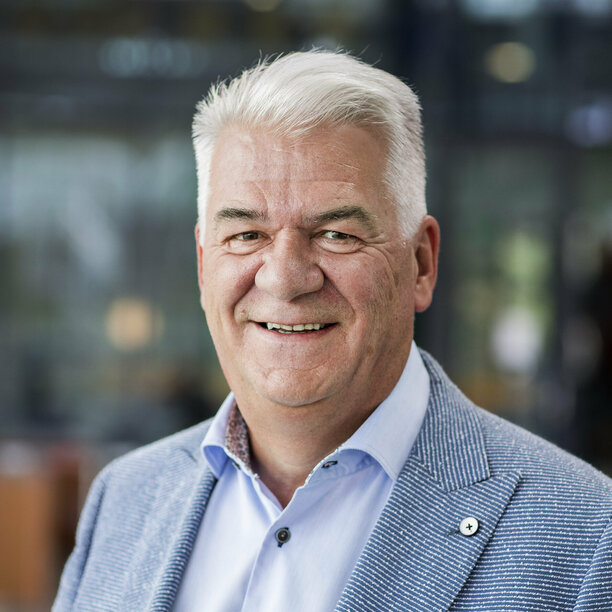Philip de Goey: a man with a mission
EIRES professor Philip de Goey is a man on a mission. Since 2015 he has relentlessly been pushing the development of iron powder as a medium for large-scale, long-term storage of sustainable energy. ‘Over the past decade, we have built an international track record in iron power, both on an academic level and in creating business in this field. Now is the time to take the next step as a country and start capitalizing on our unique position.’
His final gig. That is how Professor of Combustion Technology in the Power & Flow group of the Department of Mechanical Engineering Philip de Goey refers to the field of research he personally initiated at TU/e in 2015. ‘At the time, I had some ten years to go until my retirement as a professor, and I was contemplating a new goal to pursue in this final phase of my scientific career.’ It was during a meeting in the frame of the ESA project Perwaves that De Goey became intrigued by the concept of storing sustainable energy in metals. During the two hour commute back to his home, he planned an entire trajectory of how to turn this dream into a reality, and preferably within his remaining working life.
People project
‘Before we joined the Perwaves project back in 2010, we had never even worked on metal combustion before,’ De Goey recollects the story of how the Eindhoven metal fuel research originated. Oddly enough, it all started with a group of researchers in Odessa, working on the generic topic of oxidation of metals, back in the nineties. Three of the people from that group were instrumental in bringing the metal fuels research to Eindhoven: Samuel Goroshin, who transferred to McGill University in Canada, Viktor Kornilov, who came to De Goey’s group in Eindhoven to pursue his PhD on a non-metals related combustion subject, and Yuri Shoshyn, who later came to De Goey’s group as well.
In a meeting early 2015, the idea came to us that if you could prevent the powder from evaporating during combustion, you could perhaps use the metals to store energy in a clean and cyclic way.
Prevent smoke
‘Around 2009, Jeff Bergthorson from the McGill group approached me to collaborate with him in the ESA project on the study of powder combustion in zero gravity. At that time, here in Eindhoven we were working on combustion of gases and liquids, but I thought it would be interesting to join his project and investigate how the propagation of flame fronts in powder aerosols takes place. While clean burning of solid fuels is difficult enough as it is, when it comes to metals, we always assumed that it would be impossible to achieve a clean oxidation. Take fireworks as an example: when you burn the metals inside, you typically end up with huge clouds of smoke. But in that meeting early 2015, the idea came to us that if you could prevent the powder from evaporating during combustion, you could perhaps use the metals to store energy in a clean and cyclic way. This brainwave in 2015 marked the start of a completely new field in combustion science and technology: the use of metals as carriers of sustainable energy by using repetitive combustion and reduction of metal powders.’
Research and development in parallel
At that time, De Goey had already published hundreds of scientific papers. His colleagues at McGill University only worked on the oxidation step, and merely from an academic, curiosity driven perspective. That is why during his commute from Noordwijk to Budel, De Goey decided that in his final ten years as a scientist he would not only focus on the burning of metals and on reducing the resulting oxides back into fuel, but also in parallel on how to bring this technology to market.
Network and funding
One of the first things the scientist focused on, was to bring together academia, governments and industry to jointly work on this technology. In 2016 this resulted in Metalot, a network organization where innovation, research, business and education come together to accelerate the pace of sustainable, circular developments in the field of metals and renewable energy. In the meantime, his research group was starting first experiments on metal combustion, and applying for research grants to explore both the combustion of iron into iron oxide, and the reduction of the iron oxide back to iron. Gaining funds was far from easy, De Goey recollects. ‘Our first four larger scale research proposals were all rejected.’ But the pioneer remained confident, and together with his partners from Metalot and TU/e, he continued to advocate the potential of metal fuels as a sustainable storage solution for the energy transition. From 2019 on, his message started to resonate with funding organizations, and the project grants started to pour in. As a result, at the moment, an impressive part of the 95 Power & Flow group members is working on metal fuels related concepts. As a result of many presentations De Goey gave over the last 5 years, many other groups meanwhile follow (e.g. Universities of Darmstadt & Lund) and as a result the technology currently conquers the world. Furthermore, this groundbreaking new concept was the basis for several awards and prizes, like a very prestigious ERC Advanced Grant, an ERC Proof-of-Concept Grant and the TU/e Team Science Award 2023 for the complete Iron Power consortium.
Rather soon we were convinced that iron would hold the highest promise when compared to for example aluminum or magnesium. This is partly since there already were carbon-free methods to reduce the iron oxide back to iron, but a more important reason is that in iron, the flame temperature is comparable to that of natural gas, enabling the retrofitting of current fossil fuel infrastructure.
Technological challenges
Over the years, the research has tackled multiple technological challenges, starting by selecting the right metal to focus on. ‘Rather soon we were convinced that iron would hold the highest promise when compared to for example aluminum or magnesium. This is partly since there already were carbon-free methods to reduce the iron oxide back to iron, but a more important reason is that in iron, the flame temperature is comparable to that of natural gas, enabling the retrofitting of current fossil fuel infrastructure. This of course greatly simplifies the introduction of a new fuel.’
In the various projects, the researchers have looked at aspects like: How to keep an iron flame burning (‘as one possible solution, we investigated a tornado-shaped combustion device and developed that into a patent’). How to produce the iron powder with the required composition and specifications (‘that is what our most recently granted project is about’). How to prevent the iron from evaporating and the iron oxide particles from sticking together. And how to reduce the iron oxide resulting from the combustion in the most efficient and most cost-effective way (‘we have built and tested three different reactor demonstrators, but we are also looking at possibilities of using new exciting innovations like direct electrolysis without the presence of hydrogen’).
Stimulus from students
‘In terms of valorization, it has been extremely helpful that in 2016 I successfully stimulated the formation of an honors student team dedicated to metal fuels, team SOLID. The enthusiasm and unbridled optimism of these young people has certainly given the developments an important boost,’ acknowledges De Goey. It was team SOLID who, as part of a Metal Power Consortium Lighthouse project, in 2020 succeeded in reaching the international headlines with a pilot to demonstrate a 100 kW steam boiler system at the Swinkels/Bavaria brewery.
In 2021, team SOLID in its turn resulted in the launch of a new start-up company, RIFT, which has acquired over ten million euros of funding and in 2023 demonstrated an iron combustion based heat boiler that heated 500 houses in Helmond for a few days. A second start-up was launched in 2022: IRON+, a joint venture between Pometon, EMGroup and Metalot. They have developed a MegaWatt size iron power plant, which was recently applied to a duration test, again at the Swinkels/Bavaria brewery. Recently, since the establishment of IRON+, Metalot stepped out to be replaced by recycling company Nowit, to maintain its independent position. Metalot is currently active in building the worldwide ecosystem.
In the starting blocks
All-in all, some 9 years after De Goey’s initial idea, everything is now in place to scale up the iron power technology toward commercially viable proportions, he says. ‘We have the scientific expertise, the practical knowhow, and the appropriate partners on board. What’s left now is primarily an engineering challenge. We want to scale-up to 10 to 40 MW systems and demonstrate their application in so called 6th cluster heat intensive industries, companies that are geographically spread across the country and cannot easily be connected to strengthened electricity networks or future hydrogen networks. This is one of the things the consortium of parties around TU/e, Metalot, RIFT, IRON+ and TNO wants to achieve together through a huge National Growth Fund proposal that we are currently preparing, which is to finance the next steps towards commercialization.’ De Goey is leading this endeavor.
What started with a technology push is changing into a market pull trend due to its meanwhile proven potential and increased visibility, the website of Metalot states. De Goey: ‘With metal fuels, we really struck gold. Now it is time for the Netherlands to take advantage of our position as a frontrunner in this field and to start reaping its benefits.’

